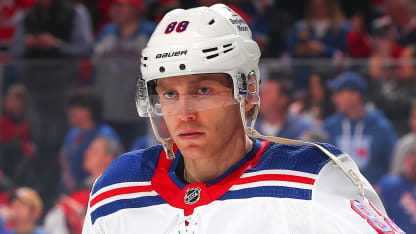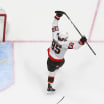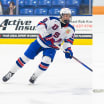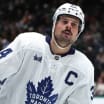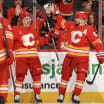Mailbag: Byfield’s impact on Kopitar with Kings; trade, free agent targets
NHL.com’s Dan Rosen answers weekly questions
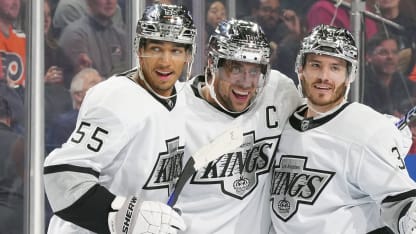
© Mitchell Leff/Getty Images
Is Quinton Byfield really going to turn Anze Kopitar into a 40-goal scorer (on pace, would be a career first)? -- @MarinaCities8
Byfield has been a factor for the Los Angeles Kings, but he's not the sole reason Kopitar has 10 goals in 19 games, a 43-goal pace for a future Hall of Fame player who has never scored more than 35 in a season. Byfield has been on the ice for six of Kopitar's 10 goals and has assists on three, but has played a role in all of them, directly or indirectly.
The best example came on Nov. 20, when Kopitar scored against the Arizona Coyotes. With Kopitar forechecking below the goal line, Byfield was in position to intercept Logan Cooley's attempted clearing pass in the middle of the Coyotes zone, above the left face-off circle. He used his long reach to drag the puck across, into the right circle, and then made a slick backhand pass across the slot to Kopitar in the lower part of the left circle. Kopitar one-timed it into the net. It was all Byfield's doing.
Byfield was also directly responsible for Kopitar’s goal against the Coyotes on Oct. 27. It was Byfield's pinch down the left-wing wall that created a turnover, freeing the puck for Kopitar to get it in the middle of the zone. Kopitar did the rest, scoring from the right face-off circle. But Byfield made the play before the play, and sometimes that's the most important one. He also did that before Kopitar scored against the Ottawa Senators on Nov. 2. Byfield won a puck battle in the right corner and got it up to Kempe, who moved it from point to point to Andreas Englund. His shot led to Kopitar scoring on a rebound, but the play doesn't get set up without Byfield's work in the corner.
These are all examples of Byfield doing what he does best, mixing skill with his big frame and long reach to create offense. He's been doing it well this season, but the No. 2 pick in the 2020 NHL Draft is not, to your question, turning Kopitar into a 40-goal scorer. If Kopitar gets to 40, Byfield will be one of the many reasons why, not the least of which will be Kopitar himself.
The Washington Capitals have a lot of cap space with Nicklas Backstrom on LTIR. Who are some of the top six forwards available? -- @samb999
Nicklas Backstrom's career might be over. His season definitely looks to be over. He's signed through next season with a $9.2 million salary cap charge. That creates options for the Capitals if he is not able to play again because of his nagging hip problems.
Here's a list of seven potential candidates the Capitals could look to acquire before the March 8 trade deadline:
Elias Lindholm, Calgary Flames
Nazem Kadri, Calgary Flames
Sean Monahan, Montreal Canadiens
Vladimir Tarasenko, Ottawa Senators
Anthony Duclair, San Jose Sharks
Adam Henrique, Anaheim Ducks
Patrik Laine, Columbus Blue Jackets
The top two are longshots in the short term because the Flames are not about to give up on this season. But if it comes that the Flames decide to re-tool, then Lindholm, who is in the last season of his contract, would be the ideal fit for the Capitals if they sustain their strong start under first-year coach Spencer Carbery. It doesn't make sense for the Capitals to sacrifice future assets to get Lindholm if they're not contenders. If they are, he could help them this season and potentially re-sign. Acquiring Lindholm would also allow the Capitals to explore trading Evgeny Kuznetsov, who is signed through next season. Kadri's is a different situation. He's signed through the 2028-29 season with a $7 million salary cap charge. That requires a bigger commitment from Capitals, and who knows if the Flames even want to part with him.
Monahan, Tarasenko, Duclair and Henrique are all on expiring contracts. They could be trade targets, but the Capitals could jump the queue to get in on one of them early if they stay in the race.
Laine is the most intriguing player on this list because he's a pure goal scorer and the Capitals need to score more goals. He was recently scratched and expressed frustration and a lack of confidence. He's signed through the 2025-26 season at an $8.7 million average annual value. Alex Ovechkin is also signed through the 2025-26 season. I don't think the Capitals are going to do a full rebuild while they have Ovechkin under contract and the timing of Laine's deal, plus the math with Backstrom expected stay on long-term injured reserve through the rest of this season, and maybe all of next season, too, makes it look like a fit.
Who are some worthwhile unsigned players out there looking for a team? -- @MrEd315
Following Patrick Kane signing a one-year, $2.75 million contract with the Detroit Red Wings on Tuesday, the first four to come to mind are Jaroslav Halak, Josh Bailey, Zach Parise and Eric Staal.
Halak was recently with the Carolina Hurricanes on a professional tryout contract for two weeks. The 38-year-old goalie was released from that PTO on Nov. 20. The fact that he was there suggests there's interest on his part to play this season. He has played in 581 games and has 295 wins. Six hundred games played and 300 wins are certainly nice round numbers and career achievements.
Bailey was with the Ottawa Senators on a PTO in training camp. He's 34 and had 25 points (eight goals, 17 assists) in 64 games with the New York Islanders last season. He could be a bottom-six veteran role player for a team in need.
Parise is in the same situation as Bailey, although he's 39. However, he had 34 points (21 goals, 13 assists) in 82 games last season with the Islanders. They were ready to re-sign him, but Parise wasn't ready to make a commitment on his playing future in the summer. He did say at the time that the Islanders would be his team if he wanted to return. The Athletic reported in October that Parise, who lives in Minnesota, was skating and could be thinking about playing again.
Staal is busy coaching his kids in hockey and enjoying family life, but he hasn’t ruled out playing again and would if the right opportunity came about. What that could be is unclear, but last season is a good example. He went to the Florida Panthers on a PTO and turned it into a one-year contract. He had 29 points (14 goals, 15 assists) in 72 games and played a fourth-line role, helping the Panthers get to the Stanley Cup Final, putting up five points (two goals, three assists) in 21 playoff games. He's 39 and has played in 1,365 regular-season games, but his big body might still have some game left in it if he wants to challenge himself.
When do teams start making big time trades? Still too early to start shipping off players? -- @sadrangers1994
I don't think it's too early if you're able to properly identify who you are and what your expectations should be for the season, but that's a pie-in-the-sky philosophy. There is a salary cap and it plays a huge role in the in-season trade market. Most of the top teams are up against it, but the longer they wait to make a trade, the more cap space they accrue. It operates on a pro-rated basis, which means it changes daily, so the cap space you have on March 8 will be different from the cap space you have today if you do nothing between now and then. That's a big reason why teams tend to wait until closer to the deadline to make their big move(s). The standings too; it's tight, particularly in the Eastern Conference. Most of the buyers don't have the cap space they need yet and there aren't enough sellers to flood the market.
The first big trade last season didn't happen until Jan. 30, when forward Bo Horvat went to the Islanders from the Vancouver Canucks. Deadline day was March 3. It's rare that you'll get a blockbuster trade like we got three weeks into the 2021-22 season, when Jack Eichel went to the Vegas Golden Knights from the Buffalo Sabres.
